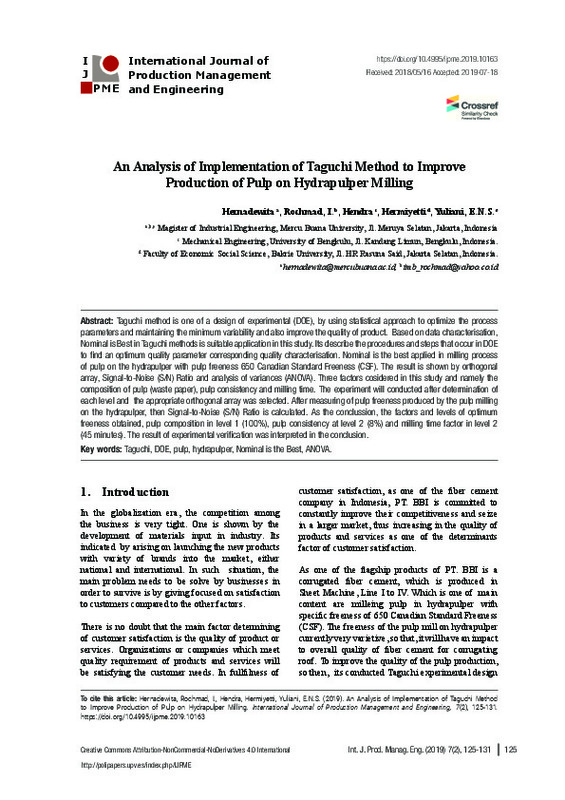JavaScript is disabled for your browser. Some features of this site may not work without it.
Buscar en RiuNet
Listar
Mi cuenta
Estadísticas
Ayuda RiuNet
Admin. UPV
An analysis of implementation of Taguchi method to improve production of pulp on hydrapulper milling
Mostrar el registro sencillo del ítem
Ficheros en el ítem
| dc.contributor.author | Hernadewita, Hernadewita
|
es_ES |
| dc.contributor.author | Rochmad, I
|
es_ES |
| dc.contributor.author | Hendra, Hendra
|
es_ES |
| dc.contributor.author | Hermiyetti, Hermiyetti
|
es_ES |
| dc.contributor.author | Yuliani, E.N.S.
|
es_ES |
| dc.date.accessioned | 2019-09-11T08:07:27Z | |
| dc.date.available | 2019-09-11T08:07:27Z | |
| dc.date.issued | 2019-07-31 | |
| dc.identifier.issn | 2340-5317 | |
| dc.identifier.uri | http://hdl.handle.net/10251/125551 | |
| dc.description.abstract | [EN] Taguchi method is one of a design of experimental (DOE), by using statistical approach to optimize the process parameters and maintaining the minimum variability and also improve the quality of product. Based on data characterisation, Nominal is Best in Taguchi methods is suitable application in this study. Its describe the procedures and steps that occur in DOE to find an optimum quality parameter corresponding quality characterisation. Nominal is the best applied in milling process of pulp on the hydrapulper with pulp freeness 650 Canadian Standard Freeness (CSF). The result is shown by orthogonal array, Signal-to-Noise (S/N) Ratio and analysis of variances (ANOVA). Three factors cosidered in this study and namely the composition of pulp (waste paper), pulp consistency and milling time. The experiment will conducted after determination of each level and the appropriate orthogonal array was selected. After measuring of pulp freeness produced by the pulp milling on the hydrapulper, then Signal-to-Noise (S/N) Ratio is calculated. As the conclussion, the factors and levels of optimum freeness obtained, pulp composition in level 1 (100%), pulp consistency at level 2 (8%) and milling time factor in level 2 (45 minutes). The result of experimental verification was interpreted in the conclusion. | es_ES |
| dc.language | Inglés | es_ES |
| dc.publisher | Universitat Politècnica de València | |
| dc.relation.ispartof | International Journal of Production Management and Engineering | |
| dc.rights | Reconocimiento - No comercial - Sin obra derivada (by-nc-nd) | es_ES |
| dc.subject | Taguchi | es_ES |
| dc.subject | DOE | es_ES |
| dc.subject | Pulp | es_ES |
| dc.subject | Hydrapulper | es_ES |
| dc.subject | Nominal is the Best | es_ES |
| dc.subject | ANOVA | es_ES |
| dc.title | An analysis of implementation of Taguchi method to improve production of pulp on hydrapulper milling | es_ES |
| dc.type | Artículo | es_ES |
| dc.date.updated | 2019-09-11T07:39:39Z | |
| dc.identifier.doi | 10.4995/ijpme.2019.10163 | |
| dc.rights.accessRights | Abierto | es_ES |
| dc.description.bibliographicCitation | Hernadewita, H.; Rochmad, I.; Hendra, H.; Hermiyetti, H.; Yuliani, E. (2019). An analysis of implementation of Taguchi method to improve production of pulp on hydrapulper milling. International Journal of Production Management and Engineering. 7(2):125-132. https://doi.org/10.4995/ijpme.2019.10163 | es_ES |
| dc.description.accrualMethod | SWORD | es_ES |
| dc.relation.publisherversion | https://doi.org/10.4995/ijpme.2019.10163 | es_ES |
| dc.description.upvformatpinicio | 125 | es_ES |
| dc.description.upvformatpfin | 132 | es_ES |
| dc.type.version | info:eu-repo/semantics/publishedVersion | es_ES |
| dc.description.volume | 7 | |
| dc.description.issue | 2 | |
| dc.identifier.eissn | 2340-4876 |








